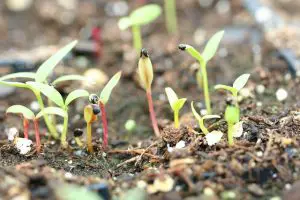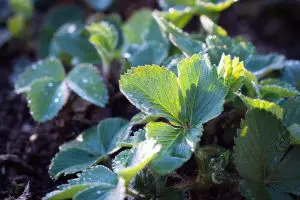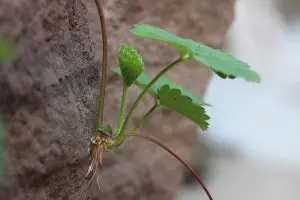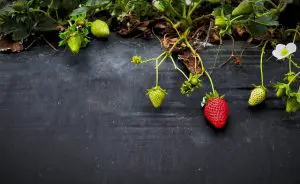You spend ages researching the type of strawberry plant you’d like to grow. Wait for them to come through the post, or appear in the garden centre. Get them home, plant them, but they don’t flower, what does it mean when strawberries don’t flower?
You made sure the soil conditions were right by adding compost or well rotted manure, watered your plants as needed. But all you have to show for your hard work is leaves, healthy green leaves, but no flowers.
What Does It Mean When Strawberries Don’t Flower?
To fully answer this question we need to look at how plants grow, why they grow, and why they produce flowers and ultimately fruit. We also need to know what nutrients are required to make plants grow to their full potential.
How Do Plants Grow?

Plants form in 3 main ways, from seed, from root division, and from runners. Let’s focus on strawberries as this is where we started. You can start strawberries from seed, but they take a lot of time to get growing.
Propagating strawberry plants from runners is the easiest way to increase your crop size. But let’s assume we have bought plants already grown and we have planted them in the soil. What should happen next is the roots spread and draw up nutrients, and the leaves turn sunlight into energy.
Once the plant is growing happily, it will produce flowers which will eventually turn into fruit, in this case strawberries. The flowers are pollinated by insects and then the fruit forms. The fruit is eaten by animals and birds and the seeds get distributed through excreta and new plants form.
What Nutrients Do Plants Require?
For plants to grow, they need the basics which include some sort of growing medium, air, sunlight, water, and an ambient temperature. For them to grow successfully, they also need nutrients, here’s a short list of the main nutrients plants need.
Nitrogen
Plants need nitrogen for leaf and stem growth, too little and then plants will be stunted and the leaves will turn yellow. Too much can cause a potassium deficiency. It’s worth remembering that nitrogen is water soluble, it can be washed away especially with over watering.
Potassium
For healthy growth and disease resistance, plants need potassium. Signs of potassium deficiency include stunted growth, brown leaf tips and leaf curl. Too much potassium can cause deficiencies in calcium and magnesium.
Phosphorus
Necessary for seed germination and growth, and for the development of roots, flowers and fruit. Signs of phosphorus deficiency include, greeny-blue leaves, that turn purple or bronze coloured and drop off prematurely. Too much phosphorus can cause a deficiency in potassium.
Magnesium
Magnesium is essential for the production of chlorophyll, which is used by the plant to turn light into energy. If magnesium is deficient plants can suffer from interveinal chlorosis, this is where the leaves turn yellow but the veins stay green. Other signs include brown or black spots, wilting, stunted growth, lower yields, flower and fruit drop, and even plant death.
Too much magnesium can cause a calcium deficiency.
Calcium
Calcium is essential for root development and growth of the whole plant. Cell walls are developed with calcium, and a lack of calcium can cause poor development of roots, distorted leaves that turn brown, and blossom end rot. It is absorbed by the plant through water, and anything that affects this uptake is detrimental to plant growth.
Conditions like high humidity, cold spells, or high levels of certain other nutrients will affect calcium uptake.
Sulphur
Plants need sulphur to produce proteins, vitamins, amino acids and enzymes. It is essential for producing chlorophyll and for the nodules that fix nitrogen in legumes. Sulphur also aids plant growth, seed production, and disease resistance.
Deficiency in sulphur leads to slow plant growth, small leaves, leaf drop and bud loss.
These are the most important nutrients needed for healthy plant growth. There are other lesser or micro nutrients that are necessary in small quantities for plant development. these include:-
- Chlorine
- Cobalt
- Copper
- Boron
- Iron
- Molybdenum
- Manganese
- Silicone
- Sodium
- Zinc
So Why Are My Strawberries Not Flowering?

If it’s the right time of year for the production of strawberries, and the plants are healthy looking, so no deficiencies. The principle reason for strawberries not to be flowering is…
Over fertilisation. Too much fertiliser in the soil, especially nitrogen. As we learned above, nutrients create the perfect environment for plant development. Get it wrong by just one nutrient, either too much or too little and it causes problems.
How To Cure The Problem
You’ll be pleased to hear this is an easy to fix problem. Nitrogen is water soluble, so if too much nitrogen is the problem, giving your plants extra water will cure it. This doesn’t mean flooding the plants, but over a couple of weeks extra watering will wash the nitrogen away.
Strawberries Producing Runners But No Fruit

This is another one of those problems that occur quite regularly and is due to the soil being too rich. Why would the plant want to produce seed when it can grow and grow runners? Remove runners and allow nutrients to wash away and you will get fruit.
The Main Reasons Strawberries Don’t Produce Fruit
There are many reasons why fruit doesn’t form on strawberries, here are the main ones.
Soil Conditions
If the soil is too nutrient rich, or has insufficient nutrients the plants won’t produce flowers or fruit.
Issues With Water
If the plants are thirsty, they’re going to be putting all their energy into surviving not fruit production. Likewise if they are drowning, plus over watering can lead to crown rot which will kill the plant.
Young Plants
If the plants are new, and young, they will take time to get established into their new home. Once they are comfortable, they’ll start to produce flowers, then fruit.
Seasonal Issues
Strawberries have differing fruiting seasons depending on variety. Some are earlies, some are lates and some are everbearing. The names say it all, earlies produce fruit early in the season and so on.
Everbearers continue to produce fruit all through the season but the fruit is often small.
Diseased Or Infested Plants
If your strawberry plants have a disease or are infested with insects literally sucking the life out of them. The plants may be too sick to produce fruit.
The Wrong Growing Conditions
We’ve looked at soil, nutrients and water, but we now have to look at positioning. Too much shade, or too much sun can both have a detrimental effect on strawberries. Hot roots, cramped growing conditions, are all factors in maintaining healthy plants.
Lack Of Flower Pollination
Lots of flowers but no fruit is probably a sign that you need to attract pollinators to your strawberry patch. Try growing a few companion plants around your strawberries. Check out my what grows well with strawberries post for ideas on companion plants.
Strawberries Feeling Soft Before Looking Ripe

This is another common problem with strawberries, and is caused by feeding them with fertiliser once fruit has formed. Don’t worry they’re perfectly edible just not as appetising to look at.
What Does It Mean When Strawberries Don’t Flower Summary
There are quite a few reasons why strawberries don’t flower, it can be :-
- Nutrients
- Water
- Soil conditions
- Runners
- Disease
- Insect infestation
- Young plants
- Type of strawberry plant
- Seasons
For more information on how to grow more strawberries follow this link.
For information on strawberry plants follow this link to the Cornell university paper on Strawberry Plant Structure and Growth Habit.

